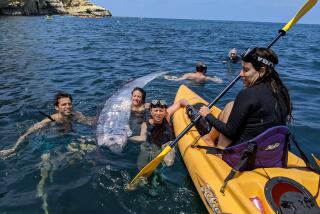Divers Down for the Count
SANTA ROSA ISLAND — One by one, the divers plunged off the bow of the boat, and edged hand over hand down the anchor line to the rocky pinnacle off the east end of Santa Rosa Island.
Waterproof clipboards in hand, the scuba divers swam past the rocks and through sea grasses, using graphite pencils on plastic sheets to tally the fish they saw.
They peered into rocky crevasses looking for the bug-eyed orange garibaldi, which tends its little clump of algae like a suburban homeowner and his lawn.
They swam through fronds of undulating kelp looking for the buck-toothed orange and black sheepshead, which can change from female to male.
And they watched for the giant black sea bass--a protected species that can grow up to 8 feet long and weigh 500 pounds. After virtually disappearing in the early 1980s, the giant fish has been sighted in recent years.
The 10 divers were part of the Great American Fish Count--an annual census conducted by trained volunteer snorkelers and scuba divers from Florida to California during the first two weeks of July.
The event, which began in 1992, is organized by the federal National Marine Sanctuary Program, Reef Environmental Education Program and the American Oceans Campaign.
This is only the second year the effort has been coordinated nationally, and only the second year data from the Channel Islands National Marine Sanctuary will be added to a database accessible on the Internet.
The data will help scientists monitor the health of the ocean and the fish living in it. But more than documenting species and habitats, organizers hope the fish count will get people to protect the oceans as if they were their own.
“When regular everyday people can go out and make a difference by generating data that can be used, they feel like they are stewards of that resource,” said Christie Pattengill, national coordinator of the count. “They start to feel it’s theirs--and that is something that is more valuable than the data itself.”
Volunteers Trained at One of 12 Seminars
The sanctuary is one of 12 around the country. Its boundaries stretch from mean high tide to six nautical miles offshore of San Miguel, Santa Rosa, Santa Cruz, Anacapa and Santa Barbara islands.
Organizers hope data generated by the fish count will help establish the largest and most reliable information to date on the types, sites and abundance of fish off the California coast.
Pattengill says the data gathered by volunteers may be less precise than those resulting from more scientific studies. But, she says, the fish count covers a larger area than that covered by other surveys.
In Florida, where the fish counts have been held since 1992, more than 13,000 data forms have been submitted, building a huge database that is “statistically very powerful,” Pattengill said.
In California, there were 327 forms submitted last year. Organizers hope to double that this year.
The count uses volunteers trained at one of 12 seminars held along the coast of California in May and June.
Many of the areas they search have never been surveyed.
Although the fish count lasts two weeks, biologists hope they will be able to train enough people so the counting can continue year-round.
10 Divers Descend Into 58-Degree Waters
On a recent day, the 10 volunteers motored out of Santa Barbara Harbor at 4 a.m. aboard the Truth, a boat that ferries divers and fishers to sea.
They were bound for San Miguel Island, the second-most isolated island of the five in the Channel Islands National Park.
But heaving swells cut short the five-hour trip. Instead, the Truth moored off the east end of the wind-swept hills of Santa Rosa Island.
Pattengill went through a pile of waterproof flash cards showing the 20 most common species in the Channel Islands Marine Sanctuary, and their characteristics.
Then, at 8:30 a.m., the divers--squeezed into layers of neoprene, and breathing heavily through oxygen tanks--descended.
The 58-degree water was teeming with life.
Orange cigar-shaped senoritas, flicking their black tails like fans, darted in and out of the kelp.
Iridescent blue half-moons and opaleyes swarmed through the turquoise water.
Volunteer Dan Bellerue of Santa Barbara, who designs software for banks, emerged from the water thrilled because he spotted a big-headed cabezon for the first time.
“I think this is neat,” Bellerue said. “Most divers just like to look, and doing the fish count makes you look more. It makes you appreciate what you are seeing. You’ve got a name all of the sudden.”
The volunteers shared the boat with at least 15 spear fishers who were killing some of the same fish the volunteers were counting.
This prompted some volunteers to ask if their tallies should be amended as the spear fishers hauled in their prey.
“I had just counted a sheepshead and this guy was trailing a dead fish on his line,” volunteer Nancy Truman said.
Results of 1998 Count Released in Late August
Back on the boat, the divers rushed into the galley and frantically flipped through fish identification books, trying to find the mystery fish seen on their last dive.
Pattengill said the warming of ocean waters due to El Nino has decreased the kelp habitat around the islands. That, in turn, will probably affect the final tallies of fish, she said.
But results of this year’s count will not be available until late August.
As the boat cruised back to Santa Barbara, Pattengill announced the tally for the day: 19 forms submitted and 21 species spotted.
Without data like these--as insignificant as they might seem--biologists cannot even document whether fish populations are increasing or decreasing.
In the case of Santa Rosa, these are the first forms ever submitted to the fish count.
“People don’t realize what’s going on underwater,” said Truman, who does voice-overs for television commercials in Los Angeles and volunteers for the American Ocean Campaign. “People think our oceans just regenerate. And they don’t.”
More to Read
Sign up for Essential California
The most important California stories and recommendations in your inbox every morning.
You may occasionally receive promotional content from the Los Angeles Times.










